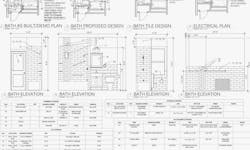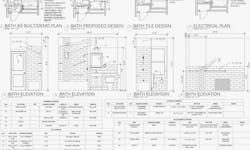How to Write Specs That are Clear, Concise, Correct, and Complete
A set of detailed project specifications, or specs, save time, money, and aggravation by ensuring that everyone works off the same page. They show clients exactly what to expect, and they make pricing more accurate.
Remodelers who write detailed specs couldn’t imagine working without them. “Costs on our last 35 jobs were within 0.82 percent of estimate and our change orders are consistently just 2 or 3 percent of annual volume,” says Paul Eldrenkamp, owner of Byggmeister, a design/build firm in the Boston area. He adds that it’s his company’s detailed specs that have made the difference.
So why do so many remodelers fail to write good specs? The answers include misunderstanding about how to do them right and concern that putting in enough detail will take too long.
Communicate with the customer
Effective specs encompass every important feature and product on the job. Remodelers new to spec writing usually start small by defining critical products for client approval and processes that they need workers to do a certain way.
“Good specs don’t have to be long,” says Michael Anschel, principal of Otogawa-Anschel Design+Build, in Minneapolis. “But,” he adds, “they do need to include the critical components you need people not to screw up.” It’s important to provide a lot of detail in those areas, such as plumbing and electrical work. For example, some remodelers merely write “electrical to code,” and list the type and color of switches and outlets on the plans, figuring that’s enough information. But that can lead to problems down the road. “If you specify a light switch with no additional information, you risk having the customers get upset when you tell them that the stainless steel outlet covers they want are going to cost an extra $4 apiece,” Anschel says. (Note: Effective specs encompass every important feature and product on the job. Here, Otogawa-Anschel Design+Build provides enough detail to avoid misunderstandings with the homeowner, reduce change orders, and clarify a number of procedures for employees and trades. Click on the image, above, to see a full-size sample spec from Otogawa-Anschel Design+Build. )
A better spec, he explains, would be something like, “Four almond-colored duplex GFCI receptacles installed in a vertical orientation with white plastic outlet covers.” If the customer wants an extra outlet or a different type of cover, it’s clear that they need to get a change order from you.
Or take the example of bathroom plumbing fixtures.
A VAGUE SPEC FOR A MASTER BATH MIGHT BE AS FOLLOWS:
- Sink type: Kohler vanity sink
- Sink color: Beige-white
- Faucet: Delta
- Faucet finish: Standard
- Dimensions of sink placement in countertop: Centered
A BETTER SPEC WOULD BE:
- Sink: Kohler Tresham K-2979-8-0 vitreous china vanity top with integral sink
- Vanity top height: 32 inches above the finish floor
- Color: Biscuit
- 8-inch center faucet holes
- $400 allowance for bath fixture
- Sink location will be per cabinet plan on page P3 of the blueprints
“You want to write the spec so the owners can’t argue with you about what sink to use or where to place it,” says Dennis Dixon, a remodeler, author, and consultant based in Flagstaff, Ariz.
Communicate with subcontractors
Specs are also helpful in setting expectations for subcontractors. A set of standard practices for your trades will spell out critical details on every project. These may include visuals to help installers correctly complete critical parts of the job, such as instructions from the DuPont website on how to flash a window and integrate it with the Tyvek housewrap, says Doug Horgan, VP of best practices with BOWA, in McLean, Va. “Rather than just specifying the type of window flashing, we include the drawings to show how we want it done,” he says. Specs can include instructions that tell trades how you want things done. BOWA has a 63-page Trade Standards document (below) that includes sections for carpenters, roofers, insulators, plumbers, electricians, HVAC installers—even the companies that install fire sprinklers and central vacs.
BOWA remodeling company trade standards document-coverIt’s especially important to clearly define any one part of the job that will affect another. For instance, Shawn McCadden of RemodelMyBusiness.com, an industry trainer, and former remodeler, points out that if you want the flooring of an addition to seamlessly meet that of the existing home, the height of the subfloor will depend on whether you are using ¾-inch strip oak or ¼-inch-thick engineered flooring. Getting the subfloor right will be easier if you pour the foundation at the right level. “If you don’t define the kitchen flooring before pouring the foundation, how do you know what height to pour the concrete?” McCadden asks.
On the other hand, there’s usually no need to define construction details where the workers understand company expectations. If your carpenters know how to correctly install sheathing, you probably don’t have to call out details such as nailing patterns.
It’s a good idea to orally review your specs for construction details with new subcontractors. For example, Anschel’s roofing specs require metal drip edge along all roof edges, something most roofers in his area don’t automatically install because it’s not required by local codes. If the roofing sub sends a crew that hasn’t worked on one of his jobs before, the job supervisor reviews this requirement with them.
You can present this information in whatever way suits your business. Some remodelers put details on the blueprints, including model numbers of plumbing and electrical fixtures. Others put most of this detail—from concrete and framing lumber to cabinets, hardware, wall paint, and roof shingles—on separate documents.
Clear communication builds profit
“Although I put a lot of information on my drawings, I create separate, very detailed schedules for lighting and plumbing fixtures,” says Doug Walter, a Denver architect who works exclusively with remodelers.
If the clients already have a design, then meeting with them and the subs on site and writing an estimate with detailed specifications should take between 10 and 16 hours for a major kitchen remodel and maybe 4 hours for a 30-square-foot bath, McCadden says. He adds that the time is an investment rather than a cost. “Ask yourself: Will it take longer to do this work right or to be constantly answering questions and correcting mistakes?”
Done right, this work also gets easier with each job. Dixon is the author of Finding Hidden Profits: A Guide for Custom Builders, a subject he lectures on at industry events nationwide. He hears lots of concern about how long writing a thorough spec will take. “Contractors at my seminars all agree on the importance of good specs but complain they lack the time to write them,” Dixon says. However, he points out that while the first set of specs can take some time to prepare, you’ll be able to reuse a lot of the information and, ultimately, you’ll create a boilerplate language you can use again and again. “Start with the spec for a small kitchen or bath,” Anschel advises. “You may end up with four or five pages that become a template you can customize for other jobs.” As a bonus, you’ll have started with the most complex parts of the house, so the other rooms will generally be easier.
You don't have to reinvent the wheel every time
Boilerplate specs tend to be a work in progress, with most remodelers refining and adding to the documents over time. “If the electrician always has to ask you how high above the kitchen island you want the three pendants,” Anschel says, “start including that dimension.” He adds that one client put a level on the garage slab and asked why it wasn’t level. His crews know that a garage slab needs a ⅛-inch slope, but Anschel added it to his garage specs, in case another client asks in the future.
There may be as many different types of boilerplate template as there are remodelers, but they tend to fall into two broad categories. Dixon’s approach is one: He uses the spec documents from a previous, similar job as a template on each new job. He then handwrites any changes on a printed copy and types those into the new document.
The other approach is represented by McCadden. During the years when he ran a full-time remodeling business, McCadden created stored templates for common jobs. He also created a library of boilerplate passages for specific tasks and saved them so they could be inserted in the templates as needed.
—Charlie Wardell is a freelance writer and former remodeler in Tisbury, Mass. This article first appeared in Pro Remodeler magazine

